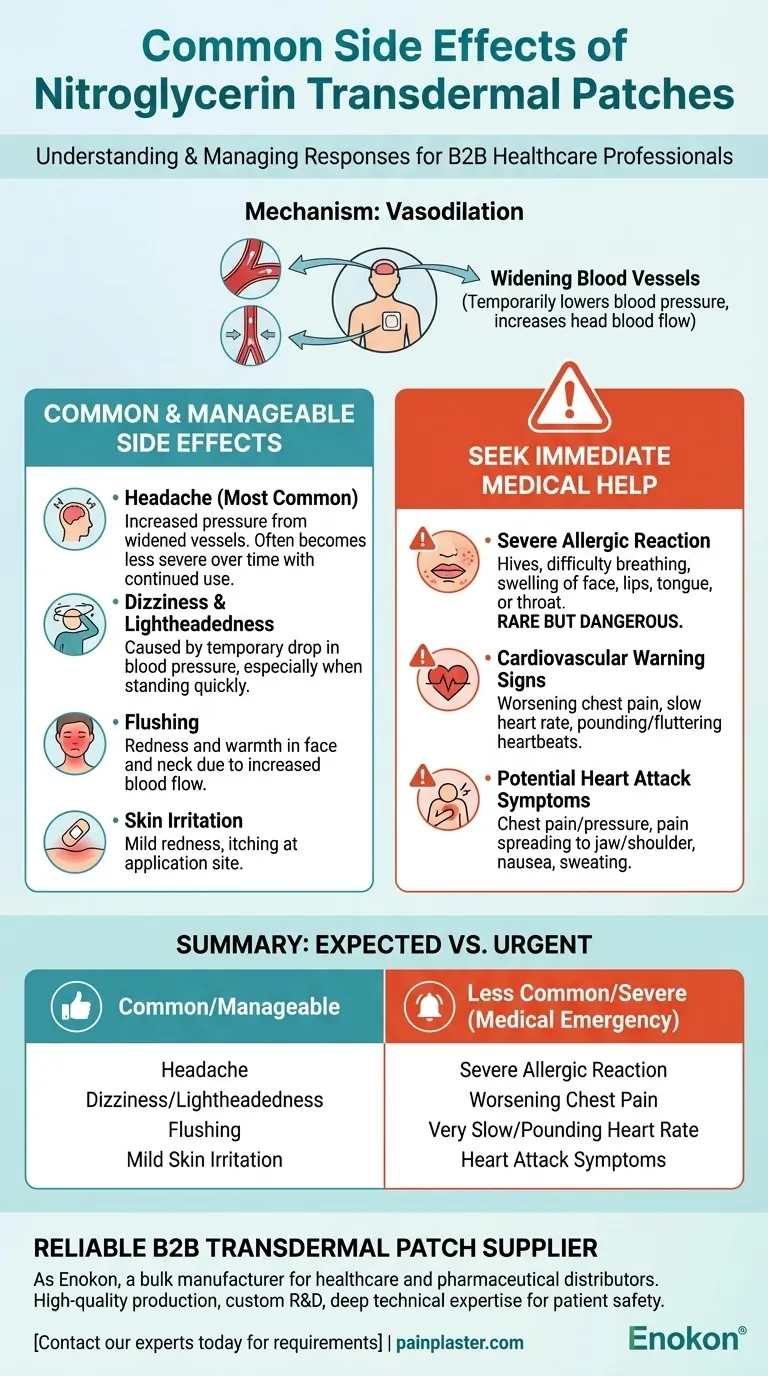The most common side effects of transdermal nitroglycerin are headache, dizziness, and lightheadedness. These effects occur because nitroglycerin works by widening blood vessels throughout the body, which can temporarily lower blood pressure and increase blood flow to the head.
While headaches and mild dizziness are expected and often improve over time, it is critical to distinguish them from severe symptoms like worsening chest pain or signs of an allergic reaction, which require immediate medical attention.

Understanding Common and Manageable Side Effects
The most frequent side effects are a direct result of nitroglycerin's primary function: relaxing and widening your blood vessels (vasodilation). These are generally not dangerous but should be monitored.
The Most Frequent Effect: Headaches
Headaches are the single most common side effect. This happens because the blood vessels in your head also widen, increasing pressure.
For many users, these headaches become less severe with continued use of the patches as the body adjusts.
Dizziness and Lightheadedness
Feeling dizzy or lightheaded, especially when standing up quickly, is also very common. This is caused by a temporary drop in blood pressure from the widened blood vessels.
Flushing and Skin Irritation
You may experience flushing, which is a redness and warmth in your face and neck.
Because this is a transdermal patch, mild skin irritation, redness, or itching at the application site can occur.
When to Seek Immediate Medical Help
Certain side effects are not normal and can indicate a serious or even life-threatening problem. You must seek emergency medical help if you experience any of the following.
Signs of a Severe Allergic Reaction
An allergic reaction to nitroglycerin is rare but dangerous. Symptoms include hives, difficulty breathing, or swelling of your face, lips, tongue, or throat.
Cardiovascular Warning Signs
Contact your doctor or seek help if you notice significant changes in your heart's function.
This includes worsening chest pain, a slow heart rate, or pounding heartbeats and fluttering in your chest.
Symptoms of a Potential Heart Attack
Nitroglycerin is used to prevent chest pain, so any signs of a heart attack are a medical emergency.
These symptoms include chest pain or pressure, pain spreading to your jaw or shoulder, along with nausea and sweating.
How to Manage and Respond to Side Effects
Your goal is to use this medication safely and effectively. Knowing how to respond to side effects is key.
- If your primary focus is managing common effects: Recognize that mild headaches and dizziness are expected. Move slowly when standing up and discuss persistent headaches with your doctor.
- If your primary focus is safety and identifying risks: Immediately call for emergency medical help for any symptoms like worsening chest pain, difficulty breathing, facial swelling, or a very slow heart rate.
Understanding what to expect empowers you to use your medication safely and with confidence.
Summary Table:
| Common Side Effects | Less Common/Severe Signs Requiring Medical Help |
|---|---|
| Headaches | Severe Allergic Reaction (hives, swelling, difficulty breathing) |
| Dizziness / Lightheadedness | Worsening Chest Pain |
| Flushing (redness/warmth) | Very Slow Heart Rate or Pounding Heartbeat |
| Mild Skin Irritation at Application Site | Symptoms of a Heart Attack (chest pain, nausea, sweating) |
Need a reliable supplier for your nitroglycerin or other transdermal patches?
As Enokon, a bulk manufacturer of reliable transdermal patches and pain plasters for healthcare and pharmaceutical distributors and brands, we combine high-quality production with deep technical expertise. We can support your custom R&D and development needs to ensure patient safety and product efficacy.
Contact our experts today to discuss your transdermal patch requirements.
Visual Guide

Related Products
- Far Infrared Deep Heat Relief Patches Medicated Pain Relief Patches
- Far Infrared Heat Pain Relief Patches Transdermal Patches
- Heating Pain Relief Patches for Menstrual Cramps
- Menthol Gel Pain Relief Patch
- Icy Hot Menthol Medicine Pain Relief Patch
People Also Ask
- How do pain relief patches compare to other pain relief methods? Discover Targeted, Long-Lasting Relief
- What are pain relief patches and how are they used? A Guide to Safe, Targeted Relief
- How do pain relief patches provide targeted relief? Discover the Science Behind Effective Pain Management
- How often should pain relief patches be used? Get the Right Schedule for Targeted Relief
- How do Deep Heat Pain Relief Patches provide pain relief? Discover the Drug-Free Mechanism















